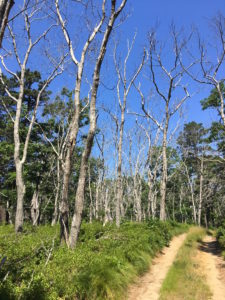
There is a trail I follow through the forest behind my house, a winding old fire road grown narrow over the years. I have walked these woods for most of my life. The walk is one I take when I need to hide from the summer heat in the shade only an oak forest provides.
Now these woods are different. The blue of the sky shows where leaves used to be. The oak trees are bare; a skeletal scaffolding of naked branches grasps at the sun.
By the time the gypsy moths left two years ago the trees along this trail were stripped bare. Cape Cod hadn’t seen rain in weeks, yet a sound like a rainstorm’s first slow, steady drops filled the forest. It was the droppings of the gypsy moth caterpillar falling to the brittle litter of the forest floor.
The caterpillars had taken up residence in the canopy, their arched bodies as efficient at destroying leaves as the leaves were at turning sunlight to life.
They ate everything. They ate the oaks, the maples, the aspens, the apples, and the birches. When no leaves were left, they ate the tough waxy needles of the spruces and pines. They ate entire swaths of forest, turning acres of soft green tissue into dense, dark kernels of frass that was our rain for weeks on end.
In 2017 alone, gypsy moth caterpillars ate one million acres of forest in Massachusetts, one third of the state’s trees. Most trees, especially oaks, can withstand defoliation and regenerate leaves within a single growing season. But the gypsy moths were here for three years, defoliating the same trees again and again, thriving in Cape Cod’s drought. These trees, well adapted to our sandy soil and salt wind, could not endure.
According to Mass Audubon, the amateur entomologist Leopold Trouvelot brought the gypsy moth caterpillar from France to his Medford home in 1869. He intended to study the insect as a means of establishing a silk industry in the U.S. The story goes that Trouvelot left a window open and out wriggled a few hairy caterpillars. In that moment, one of America’s most destructive forest pests emerged into an entire continent of hardwoods without any defense against their hunger.
The caterpillars hatch from fuzzy seed casings that have overwintered on tree trunks and begin to climb. Their singular instinct tells them to ascend and eat. After they feast, they drop, hanging on delicate strands of silk, streaming down on long shimmering lines, like raindrops leaving trails in the air. The wind blows and carries them from tree to tree, forest to forest, state to state, and they keep eating.
Walking my trail now, I pass through a patch where the white, dying trunks stand like ghosts. I remember the sound. I remember the heat and the dry. I remember the forest feeling unclean, exposed, assaulted. I remember feeling a need to do something, to defend my woods. The caterpillars were like an unceasing wind, driving us slowly mad in our helplessness. At times, it felt they were chewing away at our very perception of control itself.
For most of my life I have worked with trees and gardens. When the caterpillars came we tried to make the right decisions, choosing a few specimens to save only where spraying toxins might be the lesser of the evils.
When we see destruction like this, we perceive nature’s balance thrown into chaos. We fight and push and clench our fists and scream into the canopies. We spray, we squish the caterpillars on our walkways and feel satisfied. We exercise control in the little spheres we can manage. Beyond the edges of our yards, beyond the edges of our control, the process continues.
Then one day, without any help from us, it was over. A gentle rain came and the air cooled. A fungus, Entomophaga maimaiga, found purchase in its host and within 24 hours sent its mycelia through the cells of the caterpillars. The writhing tree trunks were still. The sound of dry, hard rain stopped. The soft, curved bodies of the caterpillars peeled back and dripped to the ground.
Today, in these woods, I see life. Where deadfall lies, arching up through the underbrush like bones of a ribcage bleaching in the sun, new growth appears. These fallen trees will rot. The bugs and fungi will do their work and break them down to a fine, soft matter that will in turn feed the forest. The spaces above, left empty, are now windows to the sky.
Here is nature moving unceasingly toward balance. The Pennsylvania sedge is tall, glowing in abundant sunlight it only ever dreamed of. Oak seedlings blanket the forest floor, a new generation setting roots. The huckleberry is so thick you cannot see the ground below, so dense it seems you could walk out across its canopy.



